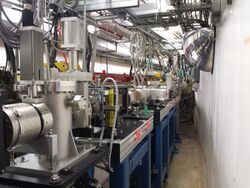Organization:Advanced Photon Source
 External view of the APS | |
| General properties | |
|---|---|
| Accelerator type | Storage ring |
| Beam type | Electron |
| Target type | Light source |
| Beam properties | |
| Maximum energy | 7 GeV |
| Maximum current | 100 mA |
| Maximum brightness | 6×1019 ph./s/0.1%/mm2/mrad2 |
| Physical properties | |
| Circumference | 1,100 metres (3,600 ft) |
| Location | Lemont, Illinois |
| Institution | US-DoE |
| Dates of operation | 1995 – present |
The Advanced Photon Source (APS) at Argonne National Laboratory (in Lemont, Illinois) is a storage-ring-based high-energy X-ray light source facility. It is one of five X-ray light sources owned and funded by the U.S. Department of Energy Office of Science. The APS began operation on March 26, 1995. It is operated as a user facility, meaning that it is open to the world’s scientific community, and more than 5,500 researchers make use of its resources each year.
How APS works
The APS uses a series of particle accelerators to push electrons up to nearly the speed of light, and then injects them into a storage ring that is roughly two-thirds of a mile around. At every bend in the track, these electrons emit synchrotron radiation in the form of ultrabright X-rays. Scientists at 65 experiment stations around the ring use these X-rays for basic and applied research in a number of fields.
Scientists use the X-rays generated by the APS to peer inside batteries, with the goal of creating longer-lasting, faster-charging energy storage devices;[1] to improve 3D printing for more durable materials;[2] to learn more about the behavior of charged particles in order to improve electronics;[3] and to map the brain to understand more about neurological diseases.[4] APS research played a role in the development of the COVID-19 vaccines in use in the United States.[5]
The Experiment Hall surrounds the storage ring and is divided into 35 sectors, each of which has access to x-ray beamlines, one at an insertion device, and the other at a bending magnet.[6] Each sector also corresponds to a lab/office module offering immediate access to the beamline.[7]
Two Nobel prizes in chemistry have been granted for work performed in part at the APS. The 2009 prize was awarded for the discovery of the structure of the ribosome,[8] and the 2012 prize for the structure of G-protein coupled receptors.[9]
APS upgrade
The APS is currently undergoing an upgrade that will see the original storage ring replaced with a new multi-bend achromat lattice, nine new feature beamlines built and 15 existing beamlines enhanced.[10] The result will be X-rays that are up to 500 times brighter than those currently generated, and beamlines that will enable greater focusing ability to examine smaller materials in sharper detail. The installation period for the new storage ring will begin on April 24, 2023, and is scheduled for completion roughly 12 months later in 2024.[11]
See also
- Keith Moffat
- EPICS
References
- ↑ "Battery of tests: Scientists figure out how to track what happens inside batteries | Argonne National Laboratory" (in en). https://www.anl.gov/article/battery-of-tests-scientists-figure-out-how-to-track-what-happens-inside-batteries.
- ↑ "Putting a Shine on Metal 3-D Printing | Advanced Photon Source" (in en). https://www.aps.anl.gov/APS-Science-Highlight/2020-11-17/putting-a-shine-on-metal-3-d-printing.
- ↑ "A new spin on energy-efficient electronics | Argonne National Laboratory" (in en). https://www.anl.gov/article/a-new-spin-on-energyefficient-electronics.
- ↑ "Researchers image an entire mouse brain for the first time | Argonne National Laboratory" (in en). https://www.anl.gov/article/researchers-image-an-entire-mouse-brain-for-the-first-time.
- ↑ "APS plays foundational role in development of COVID-19 vaccines | Argonne National Laboratory" (in en). https://www.anl.gov/article/aps-plays-foundational-role-in-development-of-covid19-vaccines.
- ↑ "Experiment Hall & Beamlines". Argonne National Laboratory. http://www.aps.anl.gov/About/APS_Overview/experiment_hall.html.
- ↑ "LOMs & Beamlines". Argonne National Laboratory. http://www.aps.anl.gov/About/APS_Overview/loms_beamlines.html.
- ↑ "2009 Chemistry Nobel to APS Users | Advanced Photon Source" (in en). https://www.aps.anl.gov/APS-News/2017/2009-chemistry-nobel-to-aps-users.
- ↑ "Advanced Photon Source lights the way to 2012 Chemistry Nobel | Argonne National Laboratory" (in en). https://www.anl.gov/article/advanced-photon-source-lights-the-way-to-2012-chemistry-nobel.
- ↑ "Argonne's Advanced Photon Source to Get $815 Million Upgrade | Advanced Photon Source" (in en). https://www.aps.anl.gov/node/11861.
- ↑ "APS Upgrade Installation Period Scheduled to Begin April 17, 2023 | Advanced Photon Source" (in en). https://www.aps.anl.gov/APS-News/2021-05-10/aps-upgrade-installation-period-scheduled-to-begin-april-17-2023/2021-05-10/aps.
External links
- "Advanced Photon Source". http://www.aps.anl.gov/.
- "Advanced Photon Source Upgrade". https://www.aps.anl.gov/APS-Upgrade.
- "Argonne National Laboratory". https://www.anl.gov/.
- "DOE Office of Science". https://www.energy.gov/science/office-science.
- "Science and Research Highlights". http://www.aps.anl.gov/Science/Highlights/.
- "APS News". http://www.aps.anl.gov/News/APS_News/.
- "Annual Reports". http://www.aps.anl.gov/Science/Reports/.
- Lightsources.org
[ ⚑ ] 41°42′13″N 87°59′17″W / 41.70361°N 87.98806°W
 |


